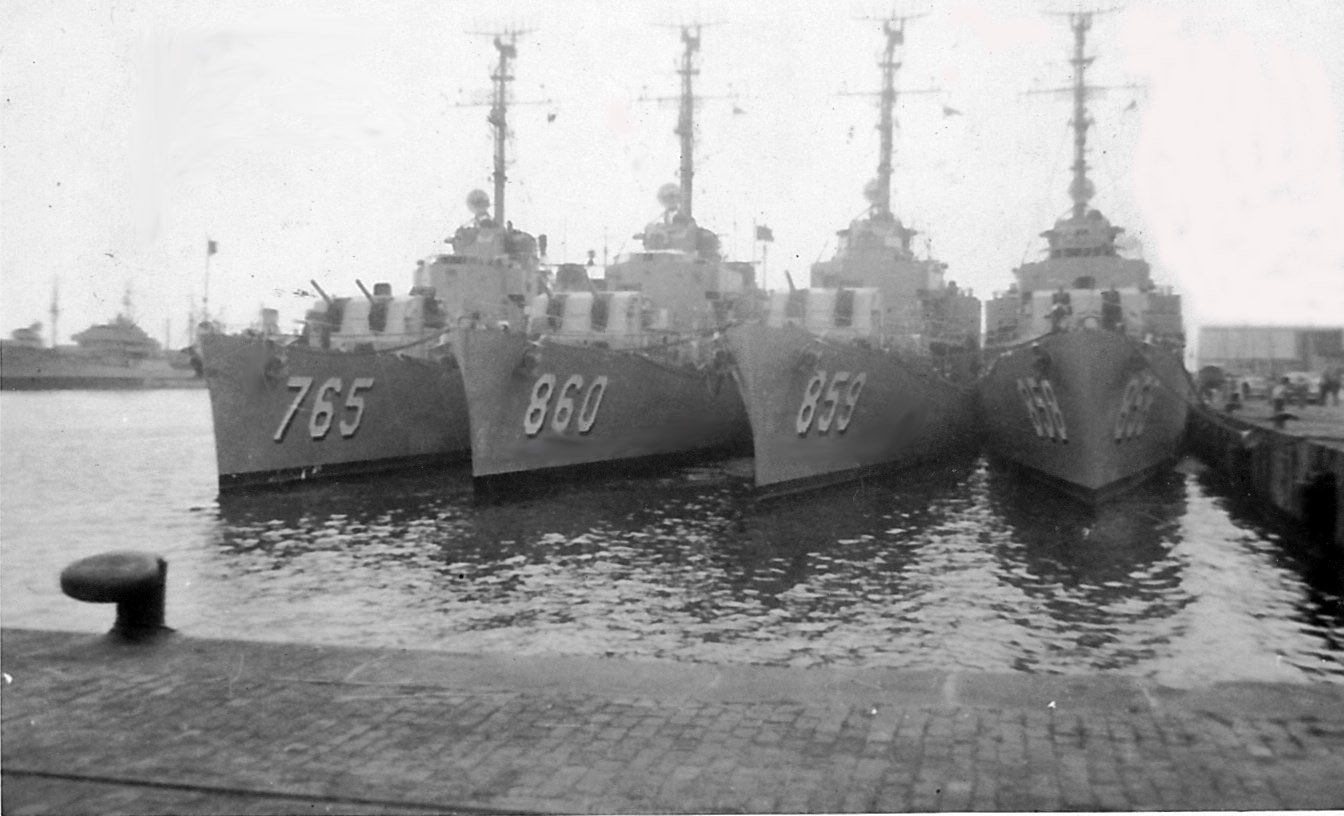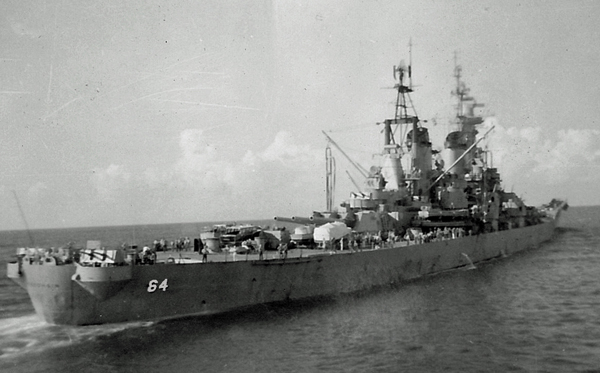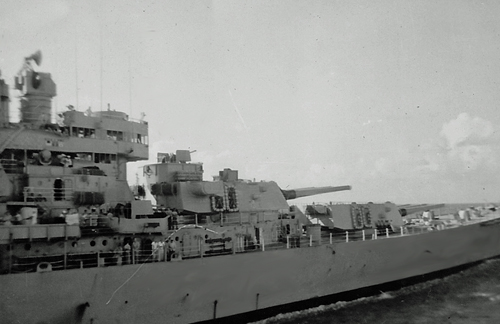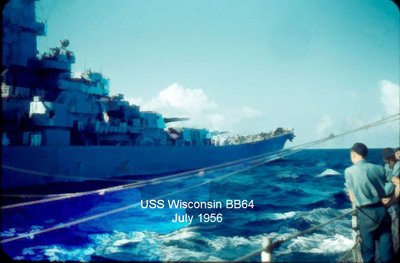|
On 1 January, McCaffery was tied up at state pier, Fall River, Massachusetts. Commanding Officer - CDR J.E. Miller
On 3 January, McCaffery got underway for torpedo firing exercises in the Newport operating area, and returned to Newport on 4 January.
CDR J.E. Miller held below deck inspection on 6 January. On 16 January, McCaffery got underway for Earle, N.J. to offload ammunition
prior to shipyard availability. On 18 January, McCaffery entered the U.S. Naval Shipyard, Brooklyn, N.Y. On 24 January, while moored
to the pier, minor damage occurred to the starboard depth charge rack and the starboard screw guard when Norris (DDE-859) came
alongside. McCaffery remained moored through 1 February.
On 5 February, McCaffery was moved by tugs into dry dock, and remained there until 14 March. Late in the day on 28 March, she conducted
dock trials. On 9 April, while still moored at the shipyard, McCaffery conducted general drills. On 10 April, with a
pilot aboard, McCaffery got underway, and conducted fire, collision, GQ, and steering casualty drills. Vibration tests were conducted
as she returned to the shipyard.
|
|
On 18 April, McCaffery moved to the Naval Ammunition Depot, Earle, N.J. On that day, Yard Tug 77, while towing a steam barge, rammed the bow of McCaffery four feet
above the water line. There was no report of damage. McCaffery loaded ammunition on 19 April, and got underway for Newport. On 20 April, McCaffery anchored at
Narragansett Bay, and conducted practice drills to get underway in an emergency situation. On 28 April, all boating activities were secured due to poor visibility
caused by heavy fog.
On 1 May, McCaffery was conducting battle problems in the Newport operating area. While tracking high flying aircraft, it was noticed that an aircraft disappeared,
and a search was begun to investigate the possibility of a downed aircraft. After an expanded search, McCaffery secured from the search since no debris was sighted.
On 7 May, McCaffery got underway for Hampton Roads, Norfolk, Virginia, and arrived on 8 May. A short time later, McCaffery got underway for Port Everglades, Hollywood,
Florida, and arrived there on 10 May. After a brief stay, she got underway for Guantanamo Bay, Cuba, conducted sonar calibration exercises en route, and arrived
on 13 May. On 16 May, she conducted firing exercises on a sleeve that was towed by a plane. On 1 June, McCaffery made a port call at Santiago de Cuba.
On 6 June, McCaffery was part of an anti-submarine exercise with USS Sea Cat (SS-399), USS Batfish (SS-310), and USS Larson (DD-830). During the exercise, McCaffery
fired a MK-32 torpedo which was lost. On 11 June, McCaffery got underway for Culebra Island for shore bombardment exercises which were evaluated by an onboard fleet
training group. On 16 June, McCaffery departed Guantanamo Bay, and moored at Pier 1, Newport, on 20 June. McCaffery remained in port to prepare
for the upcoming NROTC cruise. On 30 June, the after-engine room reported six feet of water in the lower level. Submersible pumps were put into operation. However,
no reason was given for the flooding.
Destroyer Squadron 24, formerly Escort Destroyer Squadron 6, was established 1 July 1956, and was homeported in Newport, Rhode Island. Known as the "Keystone" squadron,
the name carried over from the original formation of Escort Squadron 6, when the Commodore and all commanding officers hailed from the state of Pennsylvania, the Keystone
state. The squadron was administratively and operationally assigned to Commander, Carrier Group 6.
On 3 July, McCaffery loaded ammunition at Prudence Island in Narragansett Bay. On 6 July, McCaffery got underway with LLoyd Thomas (DD-764), Keppler (DD-765), Norris (DDE-859),
and Harwood (DDE-861) for Norfolk, VA, and arrived the next morning. On 8 July, 64 midshipmen came aboard for the summer NROTC cruise, and the cruise
group got underway on 9 July for Barcelona, Spain. In addition to ships already listed, the cruise ships included: Wisconsin (BB-64), Albany (CA-123), Gearing (DD-710),
Massey (DD-778), Huntington (DD-781), McCard (DD-822), Berry (DDE-858), and Vogelgesang (DD-862). There were two oilers in the group, Allagash (AO-97),
and Chukawan (AO-100). Various exercises and drills were conducted en route, which included highline transfers between ships of men and materiel, and refueling.
The pictures show McCaffery alongside Wisconsin to refuel.
On 18 July, the cruise group passed through the Strait of Gibraltar, and arrived at Barcelona, Spain on 20 July. As was usual in many ports, the Senior Shore Patrol Officer
came aboard to escort several crew members ashore for temporary Shore Patrol duty.
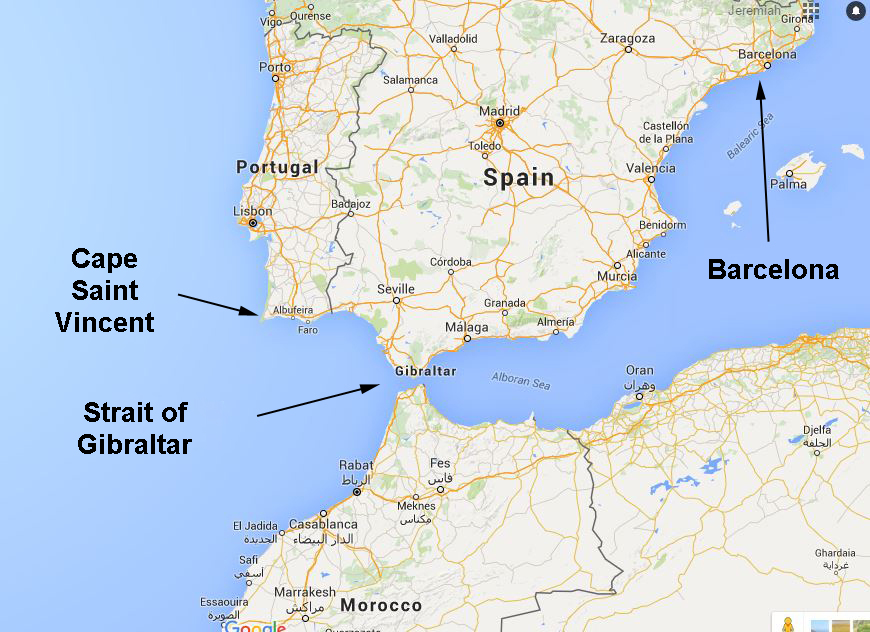
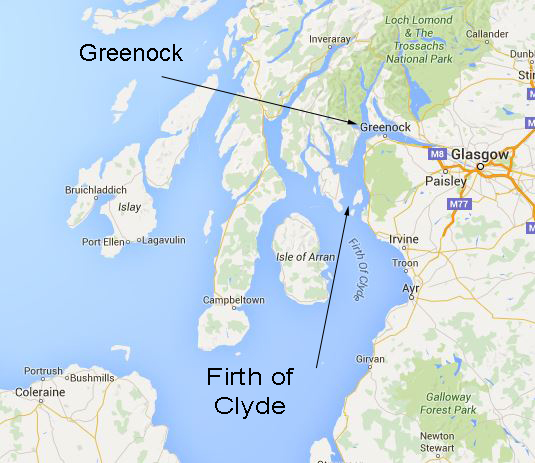
On 27 July, McCaffery and the cruise group got underway on the next leg of the NROTC cruise. After passing through the Strait of Gibraltar, the light of Cape Saint Vincent off
the southwestern tip of Portugal was sighted. On 30 July, McCaffery took station as target for surface gunfire exercises as she steamed off the west coast of Ireland. On 3 August,
McCaffery entered the Firth of Clyde, and moored at Princess Pier, Greenock, Scotland. On 4 August, McCaffery was in full dress ship in honor of The Queen Mother's birthday.
On 10 August, the cruise group got underway for the 14-day passage from Scotland to Guantanamo Bay, Cuba. On 18 August, lookouts sighted a standard navy life raft adrift, which was retrieved.
Air defense exercises were conducted during this part of the voyage, as well as atomic defense formation tactics for a simulated underwater burst astern. In addition, there were
engineering, casualty, and abandon ship drills conducted. On 24 August, McCaffery and the cruise group arrived at Guantanamo Bay. McCaffery operated in and
out of port to conduct training exercises with the midshipmen. On 28 August, the cruise group got underway for Norfolk, VA, and arrived on 31 August. With the completion
of the NROTC cruise, the 64 midshipmen disembarked. Later that day, McCaffery got underway for the overnight passage to Newport, and arrived on 1 September.
McCaffery remained in the Newport area for the next two months, and operated in and out of port on various exercises.
The Suez Canal was completed and opened in 1869. Britian had a military presence in the canal zone as a result of the 1936 Anglo-Egyptian Treaty. The Egyptian military had been pressuring the British
to end this presence in the 1950s. Supported by Soviet arms and money, and furious with the United States for reneging on a promise to provide funds for construction
of the Aswan Dam on the Nile River, Egyptian leader Nasser ordered the Suez Canal seized and nationalized in July, 1956. The British were angry with the move and sought
the support of France and Israel in an armed assault to retake the canal. On 26 October, the Israelis struck first, and two days later the British and French military
forces joined them. McCaffery's operating schedule changed as a result of this action.
On 6 November, McCaffery was ordered to cancel operations in the Newport operating area and return to port. For two days, McCaffery loaded stores for an unannounced destination,
and got underway late in the day of 9 November. After the ship got underway, the crew was called to quarters to learn that the ship had been ordered to picket duty approximately 200 miles
east of Boston to challenge all ships that approached the U.S. east coast. While on this duty, McCaffery was continually in the rough seas of the north Atlantic. Shortly after reaching
the assigned station, contact was made with an unidentified submarine. McCaffery stayed over this contact for three days, attempting to get the submarine to surface without success. Then, contact
was lost.
About two weeks into this mission, several crew members had enlistments that were due to expire. With a tanker coming to refuel McCaffery, these crew members had the choice to transfer to the tanker and proceed to port for separation
from the Navy, or extend their enlistments and remain onboard. It was rumored that McCaffery would be scheduled for a South American cruise after the first of the new year. With no scheduled
termination date from picket duty, they all chose to leave the ship by high line transfer to the tanker.
The Eisenhower administration pressured all three nations with economic sanctions if they persisted in their canal-zone attack. The British and French forces withdrew by December,
and Israel by March, 1957. As the crisis subsided, McCaffery was released from picket duty, and returned to port by the end of November at Fall River, Massachusetts.
McCaffery remained in the area shifting perths occasionally, and operated in and out of port for the remainder of the year.
On 31 December, McCaffery was moored at Newport, Rhode Island.
SOURCE: USS McCAFFERY -- 1945-1974 by Edward W. (Bill) Maslak
|
